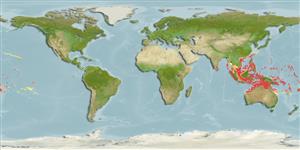Teleostei (teleosts) >
Acanthuriformes (Surgeonfishes) >
Pomacanthidae (Angelfishes)
Etymology: Paracentropyge: Greek, para = the side of + greek, kentron = sting + Greek, pyge = tail (Ref. 45335).
More on authors: Smith & Radcliffe.
Environment: milieu / climate zone / depth range / distribution range
Ecology
Marine; reef-associated; non-migratory; depth range 7 - 100 m (Ref. 9710), usually 20 - 70 m (Ref. 9710). Tropical; 35°N - 25°S
Indo-Pacific: Cocos-Keeling Atoll to the Society Islands, north to the Yaeyama Islands, south to the Great Barrier Reef.
Size / Weight / Age
Maturity: Lm ? range ? - ? cm
Max length : 12.0 cm TL male/unsexed; (Ref. 48636)
Inhabits ledges and caves and crevices of steep outer reef slopes; occasionally found in clear lagoon reefs (Ref. 9071). It is secretive and rarely goes out more than a few centimeters from an escape hole (Ref. 9710). Forms pairs or small groups. Usually starves when kept in captivity (Ref. 48391). Often upside-down (Ref. 48636). Occasionally exported through the aquarium trade. Maximum depth reported taken from Ref. 128797.
Life cycle and mating behavior
Maturity | Reproduction | Spawning | Eggs | Fecundity | Larvae
Burgess, W.E., 1991. Two new genera of angelfishes, family Pomacanthidae. Trop. Fish Hobbyist , March 1991:68-70. (Ref. 9071)
IUCN Red List Status (Ref. 130435: Version 2024-1)
Threat to humans
Harmless
Human uses
Fisheries: commercial; aquarium: commercial
Tools
Special reports
Download XML
Internet sources
Estimates based on models
Preferred temperature (Ref.
123201): 25.3 - 29.1, mean 27.5 °C (based on 348 cells).
Phylogenetic diversity index (Ref.
82804): PD
50 = 1.0000 [Uniqueness, from 0.5 = low to 2.0 = high].
Bayesian length-weight: a=0.03090 (0.01378 - 0.06932), b=2.88 (2.69 - 3.07), in cm total length, based on LWR estimates for this (Sub)family-body shape (Ref.
93245).
Trophic level (Ref.
69278): 2.8 ±0.33 se; based on food items.
Resilience (Ref.
120179): High, minimum population doubling time less than 15 months (Preliminary K or Fecundity.).
Fishing Vulnerability (Ref.
59153): Low vulnerability (10 of 100).
Nutrients (Ref.
124155): Calcium = 92.5 [45.5, 142.2] mg/100g; Iron = 0.683 [0.423, 1.117] mg/100g; Protein = 18.1 [16.9, 19.3] %; Omega3 = 0.123 [0.075, 0.197] g/100g; Selenium = 27.7 [15.4, 50.9] μg/100g; VitaminA = 96.3 [26.4, 338.4] μg/100g; Zinc = 1.63 [1.12, 2.34] mg/100g (wet weight);
